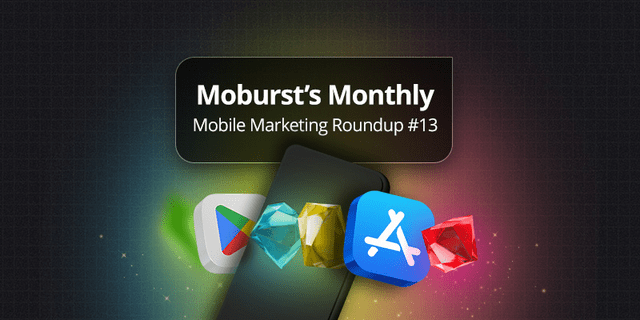
In this blog, AppTweak, leading ASO tool for apps and games driven by data science, explains all about keyword optimization on the App Store and on Google Play. Read on to learn about App Store Optimization, the importance of keyword optimization in increasing your app’s visibility and driving downloads, and AppTweak’s 4-step process to effective keyword optimization.
Ready to unlock your app’s full growth potential? Sign up for a 7-day free trial with AppTweak and discover unique features that can take your ASO strategy to the next level.
What is App Store Optimization?
ASO, or App Store Optimization, is the process of improving an app’s visibility in the app stores with the objective of increasing organic app downloads. Apps are more visible when they rank highly on a wide variety of search terms, maintain a high position in the top charts, or get featured on the store.
What is Keyword Optimization?
ASO mainly focuses on two pillars: keyword optimization and conversion rate optimization.
- Keyword optimization: Keyword optimization involves researching, analyzing, and selecting the right keywords to add to an app’s title, subtitle, keyword field, and long description.
- Conversion rate optimization: Conversion rate optimization is the systematic process of adjusting the textual and visual elements of an app’s product page, ensuring a higher percentage of users download the app after seeing it.
These two pillars work closely together: a solid keyword optimization strategy will result in higher rankings, while great conversion rate optimization techniques will make sure this increased visibility leads to more app downloads.
To understand why keyword optimization is so important to your ASO strategy, you should first understand how the app stores differ from the web:
- Search intent: Search queries on the app stores are generally shorter than on the web. People tend to search for specific apps by their brand name or look for new apps that can serve an exact need. On the other hand, when searching the web, people often seek answers to specific questions or make queries about buying a certain product or service; therefore, search queries tend to be longer.
- Keywords: On the app stores, keyword optimization is limited to the app title, subtitle, and keyword field (iOS only) or long description for one specific app. Therefore, app marketers need to carefully select a handful of relevant keywords to increase their visibility. On the web, however, it is possible to optimize different web pages for different search queries.
- Backlinks vs app downloads: Search engines rely on the amount and quality of backlinks to determine a website’s authority. To assess authority on the app stores, app download velocity is considered instead; the more downloads an app receives over an amount of time, the higher the ranking chances for that app.
- Page speed vs uninstall rate or retention rate: Both search engines and app stores want to provide users with the best user experience. As a result, search engines prioritize websites with fast page speeds in the search results. On the other hand, app stores rely on user metrics, such as uninstall rate or retention rate to feed their algorithm.
Why is Keyword Optimization Important?
According to Apple, most apps are discovered through app store searches. More specifically, around 65% of all downloads occur directly after a search on the App Store.
The App Store and Google Play Store each have their own unique algorithms but their main ranking signals are similar. In particular, to decide whether or not to rank your app on a certain keyword, the store algorithms look at the keywords provided in the metadata (title, subtitle & keyword field for iOS apps; title, short description & long description for Android apps).
If a keyword that users search for has been added to your app’s metadata, your app has a chance to rank for that search term. The app store algorithm will assign your app a higher rank if the keyword is found in your app title compared to the keyword field or long description. As a general rule of thumb, keywords in the app title carry more weight than keywords in the subtitle which, in turn, carry more weight than the iOS keyword field or long description.
Other ASO ranking factors include:
- App download volume & velocity
- Conversion rate
- Ratings & reviews
- Retention rate
- App performance
- Backlinks
4 Steps to Effective Keyword Optimization
1. Conduct Extensive Keyword Research
The first step to effective keyword optimization is extensive keyword research. You should build a list of keywords (a semantic dictionary), based on:
- The keywords you already use
- In-house and/or automated keyword brainstorming
- Your competitors’ metadata
- Your and your competitors’ reviews
- Ad keywords (Google Universal App Campaigns, Apple Search Ads)
Keyword research will help you identify which keywords already convert best and should be included in your metadata. Below, we will discuss a few of these methods:
In-House and/or Automated Keyword Brainstorming
Your keyword optimization process should always begin with a list of 100 to 200 keywords related to your app – this is called a brainstorm list. To build a good brainstorm list, you need to think big: What keywords are potentially related to your app? Put yourself in your users’ shoes and think outside the box to find a broad range of relevant keywords. Aim to identify shorter keywords that are able to combine with others – the shorter the keyword, the more combinations are possible. Also, keep in mind that long-tail and niche keywords have been proven to be effective.
Of course, building a 100-keyword brainstorm list can be a tedious task. Thanks to the data AppTweak has accumulated over the past years, its keyword research tool identifies thousands of keywords related to your app or apps similar to yours. It then analyzes each of these words to keep only the most relevant keywords with significant search volumes to quickly build a brainstorm list for your app.
AppTweak’s Keyword Picking Tool also offers many different keyword suggestions, such as:
- Description keywords: Words appearing at least twice in your and your competitors’ app descriptions.
- Download keywords: Words that bring you and your competitors the most organic downloads.
- Ranked keywords: The list of keywords for which both you and your competitors rank within the top 100 apps.
- Auto-suggestions: What the algorithms suggest to users when they start typing a search.
- Search Ads keywords: Top bidding keywords for both you and your competitors.
- Paid keywords: Keywords on which you or your competitors are bidding on Apple Search Ads.
- Category keywords: The top-ranked keywords for the top apps in your category.
- Best/worst growth: Keywords that either gained or lost the most interest (search volume) among users in the past week, month, or 90 days.
Competitors’ Metadata
Spying on the keywords your competitors target in their app metadata can be valuable to increase your own app’s visibility in the app stores. Keywords that your competitors use in their app title, subtitle (iOS), short description (Google Play), and long description are public and reveal the terms that your competitors consider as priorities (remember, keywords placed in the app title hold the most weight in the stores).
For instance, Duolingo, a language learning app, targets Spanish, French, and German in its subtitle on the App Store (“Learn Spanish, French, German”). Nonetheless, when we examine the app’s top search terms – keywords that AppTweak estimates drive the most downloads – we also see that the keywords “japanese” and “learn italian” generate a lot of traffic for the app. This suggests that Duolingo also targets these search terms elsewhere in its metadata (i.e., in its keyword field, which is hidden from the public). As a result, a competing app may choose to promote similar functionalities in their metadata as, thanks to the evidence, we see that such keywords drive traffic on the stores. This can provide an opportunity to gain an edge and increase your competitive advantage.
Additionally, monitoring the generic and branded keywords for which your competitors gain downloads can help you spot if a major competitor is using your brand name to drive installs. If so, this could encourage you to adopt a roadblock strategy and aim to have all your apps rank for their own respective brand names in order to push competitors down in the search results.
Reviews
Mining your and your competitors’ reviews for keywords can help you determine your customers’ favorite and least favorite features. AppTweak allows you to access data to identify the most positive and negative keywords found in your reviews section. Pinpointing these keywords can, in turn, demonstrate those you should target in your metadata which can further drive traffic to your app if optimized well.
2. Select and Prioritize Keywords
Next, you should select and prioritize the keywords that will be included in your app’s metadata. To do this, we recommend you identify those keywords with the most potential to drive traffic to your app. For instance, AppTweak’s Keyword Research & Suggestion tools highlight metrics necessary to understand each keyword’s potential. You should consider:
- Current rankings
- Keyword volume: The amount of traffic the keyword can drive to your app
- Chance: The possibility of reaching the top search ranking positions
- Difficulty: The level of competition for that specific keyword
- Opportunities to create mid- and long-tail keyword combinations
- Relevance: How relevant the keyword is to your app
- KEI (Keyword Efficiency Index): A figure generated by AppTweak to represent a keyword’s ranking potential, accounting for both its chance and volume scores.
You should also consider your selection and distribution of branded and generic keywords. Be careful; both Apple and Google frown upon adding (other apps’) brand names to your metadata. To measure the real impact of your ASO work, you should focus on monitoring your app’s performance for generic (non-branded) keywords.
3. Add Keywords to Metadata
Having identified the highest-priority keywords, you will need to update your store listing with those with the most potential to drive traffic. On the app stores, the discoverability of your app (in both Search and Browse Traffic) depends on how your app is perceived by indexing and ranking algorithms.
- Indexing algorithms index your app’s metadata. This means that every keyword included in your title, subtitle, description, etc, helps your app be considered relevant for specific topics.
- The ranking algorithm is based on user search queries and interests. It considers information about store visitors, such as what they typically search for, or previous apps they have downloaded. The ranking algorithm studies the list of indexed apps and determines which will be shown to store visitors first, second, third, and so on. As a result, keywords that are strategically placed in your app’s metadata will influence your app’s discoverability.
In the image below, we see how different elements of your metadata can impact your app’s visibility and conversion in the store. For example, an app on the Google Play Store would get the most visibility from keywords in its title, and these keywords would also impact conversion. However, while the long description plays an important role in terms of visibility on the Play Store, less than 5% of store visitors actually choose to ‘read more’ of the long description. This makes the long description on Google Play less impactful in converting users.
Be sure to follow these general guidelines when implementing keywords into your metadata:
-
- Use single keywords, each separated by a comma
- Avoid repeating keywords you have added elsewhere in your metadata
- Target singular keywords in English (the stores should automatically rank you for the plural version; however, this may not always be the case for foreign languages)
- Avoid special characters
- Avoid wasting space on ‘free’ keywords like ‘app’, ‘free’, ‘iPhone’, ‘new’ or ‘best’
- Avoid competitor brand names & trademarked terms
- Avoid adding English keywords to a localized keyword field
You can then decide which keywords will be added to your store listing. As previously mentioned, keywords in the app title carry the most weight, with keywords in the long description or keyword field (iOS only) carrying less weight.
|
Apple |
|
|
|
App name |
30 characters. Displayed next to the icon at the top of the app page and search results. |
Currently 50 characters; to be shortened to 30 characters at the end of 2021. Displayed next to the icon at the top of the app page and search results. |
|
Subtitle or short description |
30 characters. Displayed underneath the app title in both the search results and app page. Usually cut off at 26 characters. |
80 characters. Displayed underneath the screenshots on the app page. When using portrait screenshots, the short description will usually be shown below the fold. |
|
Long description |
4,000 characters. The first 3 lines are shown underneath the screenshots. To read the full description, users have to click the ‘learn more’ button. Keywords in the long description are not indexed on the App Store. |
4,000 characters. No longer visible on the app page. Users need to click on the ‘arrow icon’ next to the short description and underneath ‘about this app’ to read the long description. |
|
Keyword field |
100 characters. The keyword field is not visible on the app page; however, Apple does index keywords added to the keyword field. |
It is not possible for Android apps to add keywords to a keyword field. |
|
Promotional text |
170 characters. Appears on top of the long description. Keywords used in the promotional text are not indexed. |
Google Play does not provide a specific promotional field. |
4. Measure Results and Iterate
Finally, you should measure the impact of your keyword changes and iterate the process. Factors to measure include: keyword movements; top keyword ranking positions; keyword download gains and losses; overall visibility score uplift; whether your app appeared in explore traffic. You can then decide how to adapt your previous methods and consider how they could be improved in the future.








